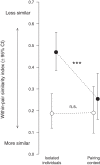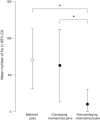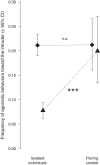Mismatched partners that achieve postpairing behavioral similarity improve their reproductive success
- PMID: 26973869
- PMCID: PMC4783125
- DOI: 10.1126/sciadv.1501013
Mismatched partners that achieve postpairing behavioral similarity improve their reproductive success
Abstract
Behavioral similarity between partners is likely to promote within-pair compatibility and to result in better reproductive success. Therefore, individuals are expected to choose a partner that is alike in behavioral type. However, mate searching is very costly and does not guarantee finding a matching partner. If mismatched individuals pair, they may benefit from increasing their similarity after pairing. We show in a monogamous fish species-the convict cichlid-that the behavioral similarity between mismatched partners can increase after pairing. This increase resulted from asymmetrical adjustment because only the reactive individual became more alike its proactive partner, whereas the latter did not change its behavior. The mismatched pairs that increased their similarity not only improved their reproductive success but also raised it up to the level of matched pairs. While most studies assume that assortative mating results from mate choice, our study suggests that postpairing adjustment could be an alternative explanation for the high behavioral similarity between partners observed in the field. It also explains why interindividual behavioral differences can be maintained within a given population.
Keywords: assortative mating; behavioral convergence; convict cichlid; mate choice; monogamy; parental care; partner compatibility; personality; reproductive success.
Figures



Similar articles
-
Hormonal and fitness consequences of behavioral assortative mating in the convict cichlid (Amatitlania siquia).Gen Comp Endocrinol. 2017 Jan 1;240:153-161. doi: 10.1016/j.ygcen.2016.10.010. Epub 2016 Oct 25. Gen Comp Endocrinol. 2017. PMID: 27793721
-
Pair-bonding influences affective state in a monogamous fish species.Proc Biol Sci. 2019 Jun 12;286(1904):20190760. doi: 10.1098/rspb.2019.0760. Epub 2019 Jun 12. Proc Biol Sci. 2019. PMID: 31185864 Free PMC article.
-
Monogamy in marine fishes.Biol Rev Camb Philos Soc. 2004 May;79(2):351-75. doi: 10.1017/s1464793103006304. Biol Rev Camb Philos Soc. 2004. PMID: 15191228 Review.
-
Why do some animals mate with one partner rather than many? A review of causes and consequences of monogamy.Biol Rev Camb Philos Soc. 2018 Nov;93(4):1795-1812. doi: 10.1111/brv.12421. Epub 2018 Apr 23. Biol Rev Camb Philos Soc. 2018. PMID: 29687607 Review.
-
Serial monogamy benefits both sexes in the biparental convict cichlid.PeerJ. 2019 Mar 5;7:e6535. doi: 10.7717/peerj.6535. eCollection 2019. PeerJ. 2019. PMID: 30863677 Free PMC article.
Cited by
-
Group phenotypic composition drives task performances in ants.Biol Lett. 2024 Jan;20(1):20230463. doi: 10.1098/rsbl.2023.0463. Epub 2024 Jan 10. Biol Lett. 2024. PMID: 38195057 Free PMC article.
-
Male Sexual Preference for Female Swimming Activity in the Guppy (Poecilia reticulata).Biology (Basel). 2021 Feb 12;10(2):147. doi: 10.3390/biology10020147. Biology (Basel). 2021. PMID: 33673367 Free PMC article.
-
Prosocial and antisocial choices in a monogamous cichlid with biparental care.Nat Commun. 2021 Mar 19;12(1):1775. doi: 10.1038/s41467-021-22075-6. Nat Commun. 2021. PMID: 33741978 Free PMC article.
-
What's in a Moment: What Can Be Learned About Pair Bonding From Studying Moment-To-Moment Behavioral Synchrony Between Partners?Front Psychol. 2020 Aug 4;11:1370. doi: 10.3389/fpsyg.2020.01370. eCollection 2020. Front Psychol. 2020. PMID: 32848962 Free PMC article. Review.
-
Personality variation is eroded by simple social behaviours in collective foragers.PLoS Comput Biol. 2023 Mar 2;19(3):e1010908. doi: 10.1371/journal.pcbi.1010908. eCollection 2023 Mar. PLoS Comput Biol. 2023. PMID: 36862622 Free PMC article.
References
-
- Spoon T. R., Millam J. R., Owings D. H., The importance of mate behavioural compatibility in parenting and reproductive success by cockatiels, Nymphicus hollandicus. Anim. Behav. 71, 315–326 (2006).
-
- Gabriel P. O., Black J. M., Behavioural syndromes, partner compatibility and reproductive performance in Steller’s jays. Ethology 118, 76–86 (2012).
-
- Schuett W., Tregenza T., Dall S. R. X., Sexual selection and animal personality. Biol. Rev. 85, 217–246 (2010). - PubMed
-
- Mariette M. M., Griffith S. C., Nest visit synchrony is high and correlates with reproductive success in the wild zebra finch Taeniopygia guttata. J. Avian Biol. 43, 131–140 (2012).
Publication types
MeSH terms
LinkOut - more resources
Full Text Sources
Other Literature Sources

